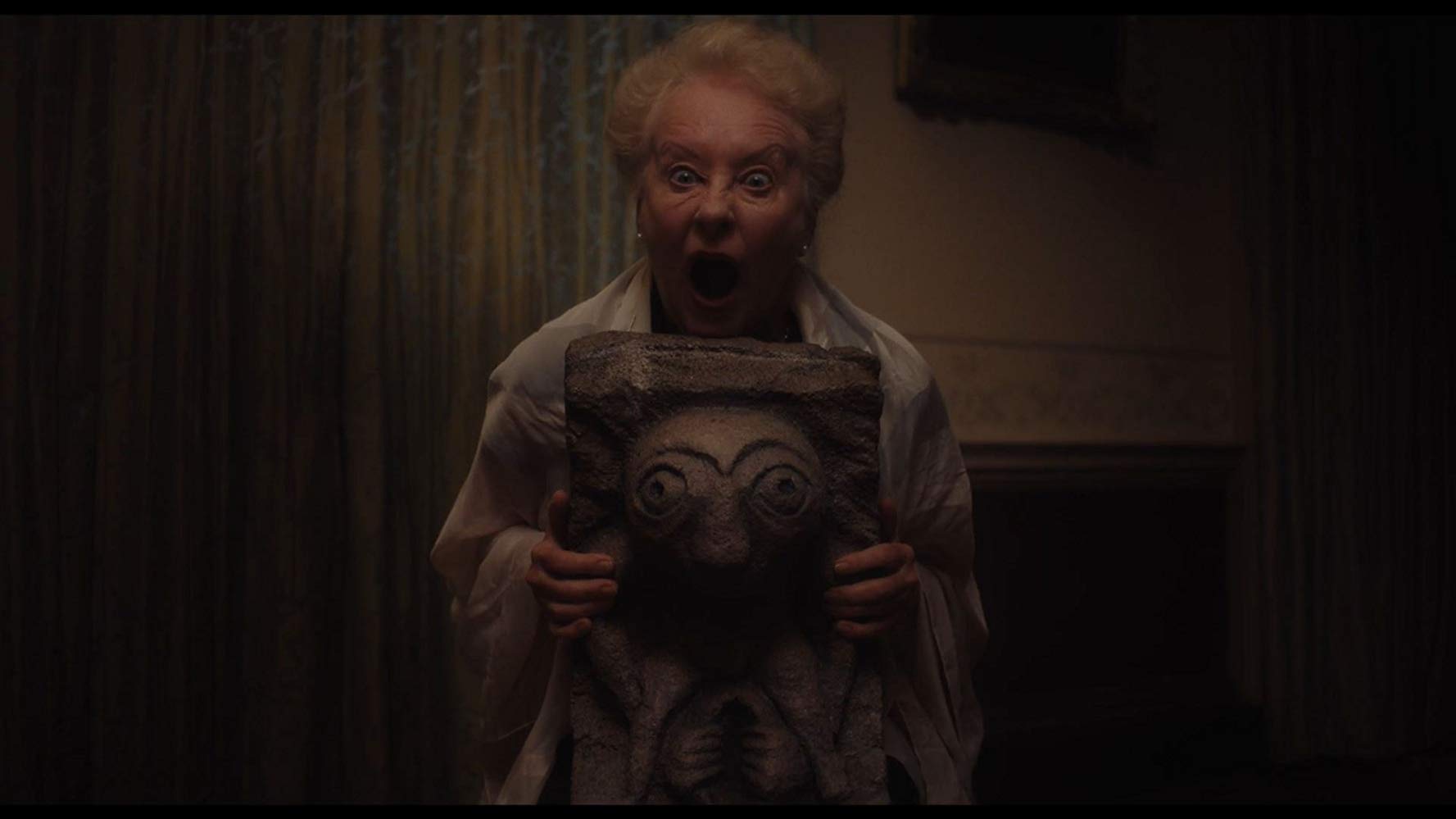While I was ridiculously satisfied with the Oak Cliff Film Festival’s lineup for 2018, I couldn’t help but feel a little stab of pain from the horror-shaped hole in the soul. So, when I found out I could catch a supernatural horror movie called Don’t Leave Home, I was elated enough to get up early and be among the first in line.
The morning screenings at OCFF tend to be leaner than the headlining night time premieres, and I was pleased to be hung-over and almost alone in the vast auditorium of the Texas Theatre, another advantage of this festival over others I’ve attended. Austin film festivals can turn into morbid king-rats, just bodies swarming over each other, clawing for space, room to breathe, and discounted beer. So, it was with a sigh of relief that I settled into the dark auditorium, getting ready for this film I knew almost nothing about. Unlike the other films I’ve covered for OCFF, I hadn’t done any outside research or reading about this one. In my experience, going in ignorant and raw is the best way to open yourself up to a horror movie.
That habit of not reading about a horror movie until after I’d seen it had served me particularly well with the last great pelicula de terror I had encountered, Hereditary. If you haven’t seen it and you’re on this site, all I can feel is pity for you. A good, creepy, stylishly ugly horror movie only comes around once in a decade or so, and when they do, they work to define an era. Where would be culturally without Rosemary’s Baby or the Exorcist? What about The Texas Chainsaw Massacre and Halloween? These movies might feel old, exhausted, and played-out today, but at the time, they were inventive, transgressive, brutal, zeitgeist defining works of collective catharsis. Was Hereditary in their league? Well, I wouldn’t have wasted precious word count blabbering about it if it wasn’t, but maybe it was exactly because of my recent transcendent experience with the former film that I was willing to be very forgiving of Don’t Leave Home.
I wasn’t expecting or even wanting Don’t Leave Home to be on the same level as Hereditary. Would I have stormed angrily out of the theatre and haughtily asked to speak to the manager if Don’t Leave Home had been as intense, nightmare-inducing and gloriously violent as Hereditary? Of course not. But after all the aftershocks of Hereditary I (and other viewers) were still experiencing, I was in the mood for something tamer.
And tamer is what I got--with some surprising notes of the shockingly scarier Hereditary thrown in for good measure. The plot of Don’t Leave Home revolves, like Hereditary, around a haunted miniature maker. But Melanie is no Toni Collette--she’s a standard starving artist type, hustling everyday to get her name out there. That’s why she’s thrilled when her latest miniature, a scene depicting the disappearance of a little Irish girl named Siobhan, is getting tons of attention. Sure, that attention might be from the disgraced and suspected kidnapper of the child, but when you’re a creative, you can’t really turn down work. So, Melanie foolishly decides to tell no one where she’s headed, packs up and heads to Ireland to meet with Father Burke, who is himself an artist.
See, there’s no physical evidence linking Father Burke to the girl’s disappearance, and he seemingly has a good alibi for the time period in which she vanished. The only fact of the case that throws suspicion on him is that the day before Siobhan went missing, Father Burke painted a sentimental portrait of her in her communion dress. Then, overnight, the girl seemingly dissolved into thin air, along with the image of her in the painting that hung with pride on her parent’s mantle. The locals in the parish deem it an “evil miracle” and Father Burke is essentially exiled into obscurity.
Don’t Leave Home is a deeply flawed film with spotty pacing, inconsistent characterization and Syfy level production values. As a film by itself, it is almost beneath consideration (which explains the ignominious eleven o’clock a.m. time slot, which might as well be five a.m. for the hard-drinking OCFF crowd). But, in several significant ways, Don’t Leave Home hits several of the same notes as Hereditary, albeit it in strikingly different ways.
First and most glaringly, both films center themselves on women who make miniatures. Why this form of art? It wouldn’t exactly be shocking if two films released back-to-back had characters who were painters or sculptors, but miniaturists? Both films use miniatures as metaphors for the turmoil of their protagonists, women whose lives are filled with uncertainty, trauma, and abuse. The artists who create the miniatures in these films use them to control and order the violent, chaotic world around them.
Another notable similarity between the two films is the presence of sinister elderly people. While this has been a fairly shop worn trope since Rosemary’s Baby made us forever afraid of sweet little old ladies, both films are concerned with the elderly as holders of tradition, as depraved seekers of pleasure or wealth, as conniving, seemingly friendly faces hiding dark secrets. Both movies depict the elderly as part of packs, roaming together, preying on the younger, stronger, ostensibly smarter protagonists.
And finally, both film’s central conflict deals with the deaths of a young girl. While Hereditary disposes of its young female lead in a scene that shook even hardened gore-hounds, Don’t Leave Home handles Siobhan’s fate with a feather light touch. But either way, whether subtle or extreme, both movies involve the turmoil introduced into the lives of families and communities when a young girl is tragically taken away.
So what to make of all these similarities? These films were made nearly simultaneously and released just weeks apart. This isn’t simply the well-known case of a lesser film ripping off the juiciest parts of a more successful one in a bid to give the greedy public more of what it wants to pay to see. That means, perplexingly, that two movies of vastly different levels of quality all deal with these very similar themes and images honestly, without consciously being in dialogue with one another.
I saw something very similar when Logan and Kong: Skull Island, two action movies both released close to each other, featured a self-sacrificing character holding up a grenade in each hand in a gesture of abandon and then delivering one last badass line before they were killed. I had all these grand plans to write a stunning article about how these two images tapped into something in the crazy Jungian unconscious, but I ultimately couldn’t come up with a working critical theory and just let it slide.
But the similarities between Don’t Leave Home and Hereditary are more than just a single image or plot point.
So, what do these repeated ideas mean?
Critical readings are, of course, deeply subjective, but both films express an overriding anxiety about the untrustworthiness of the older generation. This is an age-old fear, as common as the much more well-documented phenomena of the older generation fearing the younger. But in today’s current political world (something we can’t escape, even when we’re dealing with violent fairy tales about magic grandmas and enchanted priests), America is seemingly divided by the younger generation who wants to push ahead and an older generation terrified of the changing norms around immigration, sexuality, and gender. While neither of the films addresses any of the hot button issues that are plaguing Americans (and Twitter) today, they both deal with heroines who are seeking to find peace and a sense of control in a world gone mad, and older generation who fights to keep things just they way they like them.
Is this convergence of anxieties in these two very different films an “evil miracle,” as Don’t Leave Home dubs sinister unlikelihoods? It’s Romantic to think so, but in a realer, sadder way, these two movies just show that the fear and unsettled tensions in the world outside bleed into the movie theatre, and end up in the most surprising places.
Pennie Sublime






